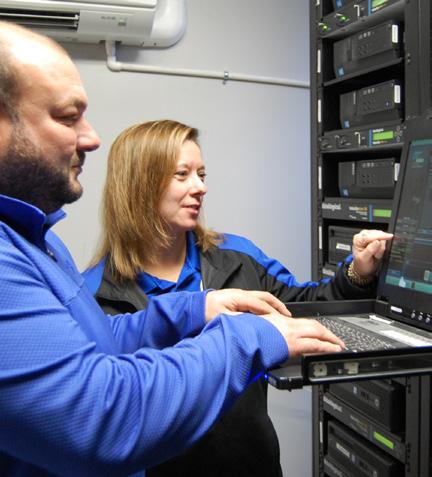MARCH/APRIL 2023


MARCH/APRIL 2023

Wayne Garmon’s captivating hobby

PLOWING AHEAD
ADVENTUROUS FUN

Closing the digital divide is an ongoing effort and not a one-time mission. Every month the diligent work of NTCA members helps to bridge these gaps. Even in the most remote areas, telcos are building world-class broadband networks and enabling critical, life-altering technologies and applications.
Our leaders here in Washington, D.C., continue to notice the gains being made in communities like yours. While the 118th Congress is still getting its feet under it, so to speak, we are seeing interest in several broadband-related bills that could help our members and their customers, and federal agencies continue to implement and execute on various broadband funding programs.
As community-based providers with a long history of service and successful performance, telcos are in a good position to vie for critical financial support for broadband deployment, such as the $42.5 billion Broadband Equity, Access, and Deployment Program. This year, we expect the National Telecommunications and Information Administration to announce allocation of this money to the states and U.S. territories, and, eventually, grants could be given out to providers like yours to serve even more people.
In anticipation of these distributions, we spent much of 2022 on Capitol Hill and with local, state and federal agencies to urge them to work closely with NTCA members. We also brought key decision-makers to NTCA meetings, conferences and webinars, and we provided members-only tools to help position telcos.
Such efforts pay dividends. For example, NTCA member companies have already received more than $1 billion in U.S. Department of Agriculture
ReConnect loans and grants. Job one for NTCA and its members continues to be pursuing policies that will enable small rural providers to keep delivering on the promises of broadband connectivity every day and for decades to come.
Fiber internet makes essential tools and services possible: commerce, education, entertainment, personal communication and more.
Here are a few examples, highlighted by the Fiber Broadband Association, offering a detailed look at how fiber networks make a difference:
1 FASTER INTERNET: Creating a network capable of keeping up with growing consumer demand for videos, music streaming and online gaming is no easy task. Fiber, however, consistently outpaces the fastest download and upload speeds of older technologies like cable, DSL and wireless.
2
INCREASED HOME VALUES: Studies have shown that fast, reliable broadband is rated as the single most important amenity for rented or multifamily homes. Access to fiber broadband increased rental and property values by as much as 8%.
3
FIBER NETWORKS HELP LOCAL ECONOMIES: There’s growing evidence fiber connectivity not only encourages businesses to stay in their locations but also helps them grow and become more productive. It even attracts new businesses, particularly in high-tech industries.
4
SUSTAINABLE: The glass that makes fiber work so well is made from sand, which is plentiful and requires less energy and creates less pollution to acquire than older technologies.
As platforms like Slack and Microsoft Teams become more popular, emoji are rapidly invading work chats. Many are self-explanatory and can help add some extra expression to a message. Others can be confusing or misinterpreted. So be sure you know what message you’re sending.

Clear communication can be a challenge at the best of times. But particularly for remote workers relying on digital chat and email tools, it’s never been easier for wires to get crossed, even during simple exchanges.
In some cases, the generation gap can rear its head even before the first word has been typed or spoken. While baby boomers and members of Generation X tend to prefer doing business face-to-face or over the phone, younger generations are much more digitally inclined.
According to research from Purdue University, both millennials and Generation Z or Zoomers — people born between the mid-1990s and about 2010 — tend to prefer communicating by email, instant message, text and social media. Having grown up with access to high-speed internet, Zoomers expect a rapid response to messages, based on a survey by marketing company LeadSquared.
It’s no secret periods at the end of lone sentences are falling by the wayside in texts, chats and social media. For some, it’s a punctuational pet peeve. But for younger colleagues, the reappearance of that little dot can carry extra meaning.
For example, while some millennials and older generations might put a period after a short message like “Thanks” or “Good job,” for Gen Z, that hard stop can imply coldness or sarcasm. Younger professionals are more likely to use exclamation points to express enthusiasm. So don’t worry, they aren’t yelling at you.
For those who came of age texting before phones could predict what you’re trying to type, quick abbreviations for common phrases were a must. BTW (by the way), TBH (to be honest), IMO (in my opinion), JK (just kidding) and IDK (I don’t know) are just a few examples.
While many of these abbreviations are now part of the internet’s vocabulary, they can be a stumbling block for anyone who didn’t grow up seeing them daily. When clarity is a priority, consider taking the extra few seconds to spell it out.
While many people use the smile emoji to denote, well, a smile, some younger professionals interpret it more ironically. That may seem confusing, but just ask yourself if there’s any warmth in that smile’s cold, dead eyes.
By and large, the thumbs up should be saved as a response to a clear yes or no question, or to acknowledge that you’ve seen a comment that doesn’t require a longer reply. Offering a thumbs up in conversations that are any more nuanced could cause confusion about whether any follow-up is needed or suggest you aren’t giving the exchange your full attention.
This one is just a public service announcement. Despite — or maybe because — the crying laughing emoji is the world’s most popular, according to Adobe, Gen Z has officially dubbed it cliche and uncool. If you’re looking to stay up on the trends, consider changing things up with the skull emoji to let them know their joke really killed.
A picture’s worth a thousand words

The SCRTC Community Network is a bimonthly newsletter published by South Central Rural Telecommunications Cooperative © 2023. It is distributed without charge to all customers of the cooperative.

This potential to help others is particularly on my mind after seeing a report that there were about 10 million job openings late last year across the nation. Now, those numbers do fluctuate, but I think it’s fair to say we’re in a time when opportunity exists — you just must be able to take advantage.
Fortunately, our fast internet service can be the key needed to unlock the world of work-from-home jobs, which can range from positions with call centers and medical records companies to careers in technology or marketing. Really, that’s just scratching the surface. No matter the industry, the innovative communications services provided by SCRTC give you the opportunity to pursue these jobs.
Internet networks like ours can tie small towns and remote areas to national employers and well-paying professions. But having the resources and skills needed to do these jobs is just the beginning. After all, you still must land that new job.
The world of employment has changed rapidly in recent years, and tapping into all the opportunities requires fast internet and some new perspective. Really, it’s a fascinating landscape.
Consider that many companies and job recruitment sites now use artificial intelligence to weed through resumes, screening them so a person only sees those who make the cut. It’s something that changes how you think about applying for a job. For instance, a CNBC article suggested listing job titles in reverse-chronological order, because the machine-based screening systems appreciate clearly structured information. Similarly, when writing a bulleted list of work experience, the first one should tie into a specific job requirement.
Also, internet-based companies like Indeed, Glassdoor and Monster connect job seekers with employers. For job seekers, these companies can provide not only daily updates of potential jobs but also offer tips for succeeding in a competitive job market.
Simply, the rules of the employment game have changed and, fortunately, you have the resources to change with them. Our communications services can help sites like Indeed come to life. These companies provide daily updates on new jobs, email blasts, tips and more.
Then, when you make a connection with a potential new employer, fast internet service can add even more of a polish. When remote jobs are on the table, videoconference interviews are common. Thankfully, fast, reliable internet can create lag-free, professional connections that put you and your abilities in the best possible light.
If all of this seems like a challenge to navigate, this same internet network can help with that, too. YouTube and TikTok have plenty of examples of experts offering advice. Meanwhile, professional social media sites like LinkedIn can help you boost your profile with potential employers.
All the resources and opportunities are made possible by fast internet service by SCRTC, and we’re committed to always providing you with the services needed to succeed.
South Central Rural Telecommunications Cooperative is a member-owned corporation dedicated to delivering advanced telecommunications technology to the people of Central Kentucky, including Adair, Allen, Barren, Edmonson, Green, Hart, LaRue, Metcalfe, Monroe and Nelson counties.
South Central Rural Telecommunications Cooperative, Inc. 1399 Happy Valley Road • P.O. Box 159 Glasgow, KY 42142-0159 270-678-2111 www.scrtc.com
Ralph J. Thompson, District I Bonnieville and Munfordville exchanges
Billy Smith, District II Canmer and Horse Cave exchanges
Jerry Polson, District III Cave City and Hiseville exchanges
Ronnie Tucker, District IV Center, Edmonton and Summer Shade exchanges
Kevin Bradshaw, District V Glasgow and Temple Hill exchanges
Zack Kender, District VI Fountain Run, Gamaliel and Lucas exchanges
Anthony Wells, District VII Buffalo and Magnolia exchanges
Jeff Eaton General Manager
Bobby H. Richardson Attorney

Produced for SCRTC by:
On the Cover:
Wayne Garmon developed an interest in digital photography, starting with cellphone photos on vacations and leading to a side gig as a shutterbug. See story Page 8.
One thing I very much appreciate about leading SCRTC is that we’re here to support the communities we serve as powerfully and in as many ways as we can. One of the best examples of this is our fast and reliable internet network, which opens opportunities for individuals, businesses, government and just about anyone who uses it.
THE CHALLENGE:
Maintain high-level security with convenient accessibility
SCRTC has a record of excellence using managed key card entry systems to secure a range of facilities:
✓ Schools
✓ Governmental buildings
✓ Any facility — from factories to pharmacies — that must safeguard sensitive data

Key card systems allow:
✓ Set entry points with access at scheduled times
✓ Granting credentialed levels of access
✓ Reviewing date and time logs of all entries
✓ Customization — including complex multizone systems
THE MISSION: Secure Barren-Metcalfe Emergency Communications Center

THE SOLUTION: SCRTC’s Access Control
The Requirements:
✓ Protect access to a vital, fast-moving community resource
✓ Secure 911 conversations that often include confidential information and personal health details — made private by federal law.
✓ Guard terminal connected to the Law Enforcement Network of Kentucky and the National Crime Information Center.
“This was necessary for the security of our employees. We don’t have to worry about buzzing someone into the building or checking who they are. It’s really handy for our dispatchers.”
"Accountability is everything now. We install the system and maintain it for our customers. They can make their own changes to manage personnel remotely with the portal we give them.”
Chris Emerson SCRTC’s Special Equipment Technician Beverly Harbison, director of Barren-Metcalfe 911 CenterTHE SUCCESS: SCRTC’s Access Control locks down access to facilities serving two counties. Barren and Metcalfe counties combined — one complex houses police, fire and EMS services.
“In addition to the key access, we purchased security cameras from SCRTC,” Beverly adds. “We can monitor our own parking lot when employees leave the building and go home after a late-night shift.”

The Southeast harbors its own kind of magic when it comes to outdoor attractions among its ancient mountains and waterways.
“It’s no secret that the Southeast United States is a remarkable hot spot for adventure,” says Terri Chapin, program coordinator for Outdoor Chattanooga. “Thrill-seekers are cool with the variety of outdoor adventures in the abundant lakes, rivers and mountain streams.”


From the region’s national parks and forests to world-class whitewater and wind sports, there’s something for everyone. And when the day is done, Terri suggests balancing your nature fix with a little urban exploration. It’s not too far from the forest to good food. “Here is the secret sauce — the Southeast blends both urban and the wild to offer endless possibilities for multiple cool adventures in one day,” she says.
The Southeast is blessed with numerous rivers offering whitewater excitement. From the Nantahala and the Green River in North Carolina to Chattahoochie Whitewater Express in Georgia, you’re in for an adrenaline rush at every stroke of the paddle.
The Ocoee River in eastern Tennessee boasts some of the best freestyle kayaking in the U.S. It was once a dammed waterway, but the Tennessee Valley Authority has been releasing recreational flows since the 1970s, creating a 10-mile stretch of Class III whitewater.
Rapids like Grumpy, Broken Nose, Flipper and Tablesaw create challenges for even the most experienced paddlers. But if you have the skills, the Ocoee has thrills. And if you don’t? Consider rafting. There are several rafting enterprises that will give you the thrills in a more-protected type experience. For a complete list of outfitters, visit timetoraft.com.
The Chattooga River begins in the mountains of North Carolina before
heading south to form a natural border between South Carolina and Georgia. Though it has a reputation of being one of the most unforgettable whitewater experiences in the South — thanks, in part, to its inclusion in the film “Deliverance” — the Chattooga is actually a river for all, from families to experienced paddlers.

There are two distinct sections. The calmest, Section III, is recommended for kayakers ages 8 and older and has numerous swimming holes. Leave Section IV for those with more experience. It has heart-stopping, Class IV rapids. For a list of rafting outfitters and guides, log onto visitoconeesc.com.
Whether you want a strenuous mountain ride or prefer to pedal through flatter terrain, great cycling trails snake through the forests of the Southeast.
The trail running through Alabama’s Chewacla State Park takes you along some of the most beautiful parts of the Southern Appalachian Trail – 696 acres of it, to be exact. Some of it is good for beginners, while other parts add more thrills for experienced cyclists. There are some hand-built trails, as well as the state’s only
wall ride — a 15-foot-high arc wall known as the Great Wall of Chewacla. For more information, visit aotourism.com.
With terrain ranging from flatlands to challenging mountain climbs, some of Kentucky’s best cycling trails are found in Mammoth Cave National Park
Mammoth Cave Railroad Bike and Hike Trail is one of those rails-to-trails experiences that offers a choice of adventures. Ride or hike the 9-mile graveled trail that, back in the 1880s, was the rail line of the Mammoth Cave Railroad. The trail offers scenic overlooks, historic sites and interpretive displays along the way. Find more excitement at kygetaway.com.
Hang gliding is a heart-stopping thrill ride that gives you a bird’s-eye view of the landscape. And the mountains around the Southeast offer the perfect opportunity to take a flying leap.
If you want a beautiful hang gliding location that offers stunning views of the Tennessee Valley, Lookout Mountain Flight Park is where you can see the “Grand Canyon of Tennessee” spread out before you.
Experienced guides offer extensive lessons with beginners starting out in the valley below. Altitude and speed on these tandem flights are gained by a tow line attached to a small aircraft. Jumping off the mountain above is only for rated pilots. For more information, visit flylookout.com.
The Wright Brothers took to the air first in Kitty Hawk, North Carolina, and now you can, too. There are no mountains, but there is wind, dunes and lots of room to run and land in soft sand. There are schools to teach you how, and it’s a good way to learn the art of hang gliding. Fly on over to kittyhawk.com for more information.
When your adventurous spirit calls out to let you know it’s time to hit the rocks, the Southeast’s sandstone cliffs are made for the sport.

The Red River Gorge occupies 29,000 acres within the beauty of Kentucky’s
Daniel Boone National Forest. Its climbing routes are a favorite with some of the best climbs and bouldering options in the world. Log on to redrivergorge.com for more information.
Climbers flock to the Tennessee Wall just north of downtown Chattanooga for hundreds of routes for climbing and bouldering. The Tennessee Wall is about 2 miles of cracks, overhanging walls, roofs and other features in a beautiful setting overlooking the Tennessee River in the Tennessee River Gorge. Visit trgt.org for more information.
Go bouldering at Horse Pens 40, a privately owned recreation area near Steele, Alabama. It’s home to a highly concentrated boulder field scattered among deciduous trees and grasslands, and it’s been attracting boulderers for decades. There’s a small fee to enter, $8-$10, and camping is available for a few dollars more. Check it out at hp40.com.
Wayne Garmon has childhood memories of his mother, Elsie Shipley, snapping images during birthdays and vacations. His curiosity led him to borrow her camera at times, taking the occasional photo of his prize possession, a white 1969 Chevy C10 truck. Those colorful memories now reside in photo albums Wayne keeps in a safe place.
He experienced the same joy his mother had when taking photos of his own kids. He started in 2000, using a pocket digital camera to capture candid moments and the sporting events his daughters, Kristen and Lindsey, participated in. “I was really just trying to capture memories as the kids were growing up,” Wayne recalls.
Today, thanks to advances in digital photography and the wealth of online resources and connections enabled by social media, what started out as a hobby for Wayne has evolved into an exciting and successful side business.
As his daughters grew up, Wayne shot many birthdays and holiday celebrations, storing thousands of images on his computer. In 2007, the launch of the Apple iPhone smartphone began to change the way people thought about photos. Wayne continued with his original digital camera for several more years before buying an iPhone 6 in 2014.
“So, we were heading to Florida on vacation, and I
decided to use my phone instead,” he says. “I took some photos of a sunrise and was just blown away at the quality, and it was so fun.” He enjoyed the versatility and many aspects of smartphone photos. Taking it one step further, he started downloading the photos to his computer to tone the images.
As Wayne continued to experiment with cellphone photography, he kept arriving at the same question. “I was interested in capturing the best image I could, and then I wondered what I could do with a real camera,” he says.
In 2016, he purchased a Sony Alpha a6000, which produces images much larger than the photos he could take on his phone. With a new
camera in hand, Wayne started exploring landscape photography, gravitating toward scenic waterfalls, forest landscapes and the occasional abandoned building. The following year, he began shooting photos of families, seniors graduating high school and brides walking down the aisle. “In 2017, I really went headfirst into photography,” he says. “I figured out pretty quick that the landscape photos don’t pay well, but with portraits, you can make some money.”
Capturing photos remains a side gig for Wayne, who works a weekday job as a quality technician at manufacturer Akebono Brake. Spring and fall are some of the busiest times for family photos. “I like to stay busy,” he says.

Wayne Garmon‘s creative hobby becomes a businessPhotos by Wayne Garmon
Wayne also saw potential in the real estate market, shooting a few properties each month. Well-lit professional images of every room can help sell a home, with 97% of homebuyers first searching for listings on the internet, according to the National Association of Realtors. Homes with significant acreage often include aerial photos and even videos to catch the eye of prospective buyers.
It wasn’t long before Wayne needed a new challenge. He began exploring drone photography for a new vantage point. He started with area farms, showcasing aerial views of how the property is managed. His clients have included England Farms.

This past year, Wayne took
on his greatest challenge with more advanced techniques. With the help of a tripod, he discovered nighttime photography, capturing the star-filled skies and planets in brilliant detail. “Astrophotography is such a challenge, and it’s so rewarding when you finally get it right,” he says. “You need to have the perfect night where the moon isn’t interfering. There are so many things that can go wrong, and that’s what I like about it.”
The advent of digital photography made capturing images much easier than back in the film days. However, it can be more time-consuming. Some photographers spend more time at their computer
editing photos than they do behind their cameras. Like many pros, Wayne uses Adobe Lightroom to select the photos he likes, and he then edits the images with Adobe Photoshop.


When he started shooting photos, clients would often order prints to frame and hang on their walls or set on the mantelpiece. More recently, families want digital images for keepsakes. Some opt for online printers offering to make their images into canvas-wrapped or even metal wall art. “Two years ago, I had a price for me to shoot the event, and then, I directed people to a website where they can order prints,” says Wayne. “Now, nobody wants that. So, I’ve got all-digital packages where you pay me and
then pay for the digital files, and that seems to be working really well.”
He uses Dropbox, one of the premier cloud-based archival systems, for clients to view and download his images. A high-speed internet connection helps Wayne upload photos for clients. His suggestion to aspiring photographers is to archive phone images often, either to your computer or to a cloud-based server.
Wayne has hosted basic camera lessons at the Mary Wood Weldon Library in Glasgow, including classes on how to take better photos with a cellphone. To see more of Wayne’s work, go to waynegarmon.smugmug. com or follow Wayne Garmon Photography on Facebook.

With the wealth of streaming services available today, there have never been so many viewing options available at the tap of a few buttons. But the constant barrage of new TV shows and movies can make it difficult to sort the wheat from the chaff, especially if you’re looking for something the whole family can enjoy.
While services like Disney+ come ready with a huge catalog of family classics, other major streamers are still building up their libraries of kid-friendly content. Here are a few suggestions to help your family start exploring the latest offerings.

“Bluey,” Disney+ — Inexhaustible Blue Heeler dog Bluey turns everyday life into amazing adventures that stimulate her imagination and emotional resilience. Broken up into short, nine-minute episodes, the Australian animated show has garnered praise for providing constructive messages while remaining engaging for adults.
“Motown Magic,” Netflix — This feel-good series celebrates music, has colorful, eye-catching visuals and instills positive messages about self-confidence. For lovers of oldies, the soundtrack is also a great introduction to Motown and soul classics.
“Sesame Street,” HBO Max — Starting with the show’s 51st season in 2020, HBO Max became the official home of “Sesame Street.” Get access to new episodes immediately so your kids can experience the fun and entertaining brand of education that “Sesame Street” has offered for decades.
“Madagascar: A Little Wild,” Hulu — Drawing on the humor and animation that made the Madagascar movies popular, this musical comedy series follows four young animals in a rescue habitat in Central Park. The show celebrates being yourself and pursuing your dreams, no matter how wild.
“Shaun the Sheep,” Netflix — Adults and young kids alike can enjoy a laugh in this claymation series from the makers of “Wallace and Gromit.” Shaun’s barnyard misadventures with his cousin Timmy, sheepdog Bitzer, cat Pidsley and fellow sheep Shirley have even spun off into several movies available exclusively on Netflix.
“Just Add Magic,” Amazon Prime Video — When Kelly discovers her grandmother’s mysterious cookbook in the attic, she and her best friends, Darbie and Hannah, find out there’s more magic to the recipes than just a secret ingredient. Loosely based on Cindy Callaghan’s popular book by the same name, the show offers magical fun for the whole family.
“Pokemon Journeys,” Netflix — This Netflix series is action-packed enough to grab the attention of new viewers and based on the anime series some parents may have watched when they were kids. Follow young trainer Ash as he travels the world learning about new Pokemon.
“Gravity Falls,” Disney+ — If your little
ones aren’t quite ready for shows like “Stranger Things” or sci-fi classics like “The X-Files,” “Gravity Falls” might be just the ticket. This show offers Pacific Northwest weirdness for the whole family as twins Mabel and Dipper Pines spend the summer with their great-uncle Stan investigating strange mysteries in Oregon.
“Star Wars: The Clone Wars,” Disney+ — Before there was a Disney series for every character in the Star Wars universe, “The Clone Wars” was filling in the gaps between the canonical Star Wars movies. The continuing adventures of Obi Wan, Anakin and young Palawan Ahsoka Tano feature enough surprisingly deep storytelling that parents might be as eager as their kids to hit play on the next episode.
“TrollsTopia,” Hulu — Picking up after the movie “Trolls: World Tour,” “TrollsTopia” follows Poppy as she attempts to unite delegates from the Country Western, Classical, Funk, Techno and Hard Rock tribes in one harmonious city. Watch as they learn to celebrate their differences with a variety of catchy tunes.
“Raising Dion,” Netflix — Second grader Dion learns to balance super powers and villain battles with the everyday challenges of growing up. The mild violence and portrayals of bullying might be a little much for younger viewers, but tween audiences will find plenty to enjoy.
“The Hardy Boys,” Hulu — Based on the popular book series, this show follows Frank and Joe Hardy when they move from the city to their parents’ hometown of Bridgeport. When their dad takes on a secret investigation, it doesn’t take long for the Hardy boys to get drawn into the mystery.
“The Quest,” Disney+ — A new take on the reality competition series from the team behind “The Amazing Race,” “The Quest” drops eight teens into an immersive fantasy world where it’s their job to save the kingdom. Find out which contestant is The One while scratching that old “Legends of the Hidden Temple” itch.
“The Dark Crystal: Age of Resistance,” Netflix — This prequel to the 1982 dark fantasy movie from Jim Henson follows a group of Gelflings as they seek to stop power-hungry overlords from draining the life from their world. Parents who enjoyed the original will enjoy the shot of nostalgia, while younger viewers marvel at the stunning visuals.
Mike England believes family operations like his England Farms are different than corporate farms. “Corporate farms are big, and powerful,” he says. “But the family-run farm, you have a connection to the land — what I call ‘sweat equity.’”
That connection keeps Mike and two of his children, Hannah and Brian, farming, even through tough years. They are the third and fourth generations, respectively, to work the Munfordville land that’s been in England hands since 1918.

Not long ago, England Farms was approached by a company hoping to purchase some of its land for solar panels. “I told the young man, ‘My granddaddy grubbed bushes and cleared that land. And if I treat it that way, he’d come back to haunt me — and he should,’” Mike says.
The farm sits on around 1,600 acres and specializes in corn and soybean production, as well as commercial Red Angus and Red Simmental beef cattle. The row crops take up around 1,100 acres, and another 500 are dedicated to the farm’s 150 cows.

The Englands operate another business, Mid South Ag LLC, distributing Mix 30, a liquid cattle feed, throughout Kentucky and Tennessee. They have a retail location for the feed at the farm. “There’s not many slow days,” says Hannah, who focuses on the cattle side of the business. Brian’s passion lies in row crops, as does his father’s.
The land has been in their family for more than 100 years, starting with Mike’s grandfather, George Thomas England. Mike’s father, Hubert Lee England, continued the tradition. Mike, 72, grew up on the farm, where he learned the value of hard work. He credits his high school principal with changing his life.
Mike got married his senior year and wasn’t considering college. Instead, he planned to work to take care of his growing family — in addition to Brian and Hannah, Mike has three biological daughters and an adopted daughter who work outside of the farm. When the principal asked, Mike said he couldn’t afford college.
Photo by Wayne Garmon An aerial view of the England Farms property shows depressions in the ground that make the land challenging to farm. Mike England, center, along with his son Brian England, left, and daughter Hannah Davis operate England Farms. Photo by Matt LedgerThe England family has a connection to the land
At the administrator’s urging, though, Mike and his father met the principal the next morning. Together they visited a few local banks to secure scholarships, grants and loans. By the time Mike got home that night, he was enrolled in Western Kentucky University, where he earned a bachelor of science degree in agriculture.
For several years, Mike lived away from the farm, working as a district sales manager. He returned home in 1978 to manage a fertilizer plant, which he did for 15 years. During that period his father took over the farm, and Mike started farming on nights and weekends. He eventually dedicated himself to the family’s farm in 1993. “You’ve got to have grit,” Mike says of farming. “You’ve got to have the passion for it.”
Hannah always knew she’d work on the farm. Like her father, she went to Western Kentucky University, earning a degree in agriculture and business management. “I always knew I wanted to come back to the farm and help manage it,” she says. “I’ve always gravitated more toward the animal side of things with our beef herd. I always knew this is what I wanted to do.”

Brian took a slightly different path. He
studied agronomy in college but ended up training to become a gunsmith. He worked in that field for a number of years. In 2012, he took a job closer to home that enabled him to work on the farm, too. He’s been with England Farms full time for almost two years now.
Both Hannah and Brian look to their dad for guidance. “We try very hard just to listen and learn from him,” Brian says. They also bring their own talents to the table with Hannah’s affinity for cattle and Brian’s technological knowledge. “Farming is just one of those things that, if you don’t love what you do, one, you’re not apt to be very successful at it, and two, you’re just going to be miserable,” Brian says. “It is a lot of work.”
Farming has its ups and downs. For instance, Mike says, 2021 marked England Farms’ best corn crop ever with
an average of more than 210 bushels per acre. This year, with almost no rain, the average was 110 bushels per acre. “You can’t fight Mother Nature,” Mike says. “You just can’t, and those kind of things are hard to overcome.”

Technology has been the single biggest change Mike’s seen in his years farming. Today, things like disease-tolerant plants help crops and vaccines for cattle keep them healthier. Equipment, too, has evolved, and that’s an area in which Brian specializes.
It’s too soon to say if Brian and Hannah’s children will become fifth-generation farmers, but the brother-and-sister duo is ready for the challenges they face going forward, especially with Mike’s guiding hand.
Brian hopes to add some acreage to in the coming years, and Hannah is looking to expand the cattle side of the business, as well.
For Mike, farming used to almost guarantee success if there was decent management, hard workers and some luck. He’s unsure if that recipe still applies, especially with today’s costs, but he has faith in his children. “We’re going to make it,” Mike says. “I’ll hang on as long as I can, but slowly and surely I’m letting Brian and Hannah take on more responsibilities. Sometimes, new and young ideas are better than the old ones.”
 Photos by Matt Ledger
Photos by Matt Ledger
While much of the rest of the world celebrates the arrival of spring with lamb, in the U.S. pink, saltysweet slices of cured pork, slathered in a sugary glaze, will fill many tables.
The problem, however, is that unless you buy a boneless ham by the pound or one of those small canned hams, you’ll probably bring home a large bone-in ham from the market or treat yourself to one from the honey ham store. And more likely than not, after you serve dinner with a couple of side dishes, you’re going to have a lot of leftovers.
There are so many ways to use up that ham that go beyond deviling or as a salad topper.

Here are three ideas to make the most of your leftover ham. They’re wonderful by themselves, or just make a day of it and make them all, using up most, if not all, of that leftover ham. There’s nothing better than a bowl of creamy ham soup with cheesy ham-studded biscuits and a delicious ham sandwich — with a twist.
4 strips of bacon
1/2 cup onion, finely chopped
3-4 medium potatoes, peeled and diced (2-3 cups)
3 tablespoons all-purpose flour

4 cups chicken broth, preferably homemade (see note)
1 1/2 cups cooked ham, cut into 1/2-inch cubes
1 cup corn, canned (drained) or frozen (no need to thaw)
1/2 cup heavy cream
1/2 teaspoon ground black pepper Salt (to taste)
1 teaspoon fresh parsley, finely chopped
Saute bacon in a large stockpot over medium-high heat until crisp. Chop the bacon and set it aside on a plate, reserving bacon drippings in the pot. Add onion and potatoes to the pot and saute for 1-2 minutes until fragrant. Stir in flour and mix well until the flour is fully incorporated. Stir in chicken broth and mix until the soup is smooth and uniform. Bring the soup to a boil over medium-high heat. Cover and let it continue to boil for 10-15 minutes until the potatoes are fork tender. Mash half of the potatoes in the
pot with a potato masher to help thicken the soup.
Stir in ham, corn, heavy cream and black pepper. Let the soup simmer over medium heat and whisk occasionally until thickened to a desired consistency, 5-10 minutes. If the chowder gets too thick, add a little water to dilute it. Add salt to taste. Serve topped with reserved crispy bacon and fresh parsley. Makes about 4 servings.
Note: To make homemade chicken stock, boil a whole chicken in water to cover with some chunks of onion and celery added. Simmer the chicken until tender. You can tell if it’s tender by pulling on the leg. If the leg comes out easily, the chicken is ready. Save the chicken for chicken salad or a chicken casserole. But save the stock, too. Salt it, to taste, and use it right away for this soup, or let it cool, pour it into a gallon-size freezer bag and freeze it.


These biscuits pull double duty as a side to soup or cut them in half, add a fried egg and make a breakfast biscuit.
3 cups all-purpose flour
1 tablespoon baking powder
1/2 teaspoon baking soda
1/2 cup salted butter (1 stick)
1 1/4 cups buttermilk
1/2 cup chopped ham
1 cup shredded extra sharp cheddar cheese
Preheat the oven to 450 F. Mix dry ingredients. Cut butter into thin slices and then cut it into the flour
until pieces of butter are small. Add in the buttermilk slowly and incorporate with the flour mixture. Don’t overmix.
Sprinkle a small amount of flour on a work surface and place dough on top of it. Press down to make flat and then add the ham and cheddar cheese to the top. Knead dough a few times to incorporate the ham and cheese.


Press or roll out into 1/2-inch thickness. Use a biscuit cutter or rim of a glass to cut out biscuits.
Place biscuits on a baking sheet and bake for 10-12 minutes. Makes about a dozen biscuits.


This is a favorite vintage recipe from Encore! Nashville, a Junior League of Nashville publication from the 1970s. Prepare ahead: These sandwiches are best made early in the morning or the day before to give time for the “custard” to soak into the bread.
8 slices bread
2 tablespoons butter, softened
4 slices ham
4 slices sharp cheddar cheese
1/2 teaspoon dry mustard
3 eggs, slightly beaten
2 cups evaporated milk or whole milk
1 teaspoon grated onion
1/2 teaspoon salt
1/4 teaspoon pepper
Dash of Worcestershire sauce
Dash of cayenne pepper
Trim crusts from bread and butter both sides well. Place 4 slices of bread
in a buttered baking dish. Place a piece of ham on each piece and cover with cheese, then top with remaining bread slices.
Combine remaining ingredients and pour over bread. Refrigerate all day or overnight. When ready to bake, spoon sauce over bread again and bake at 300 F, uncovered, until sandwiches are bubbly and golden brown on top, about 1 hour. Makes 4 servings.
Note: For a heartier sandwich, slices of tomato, avocado or bacon may be layered between the ham and cheese.



